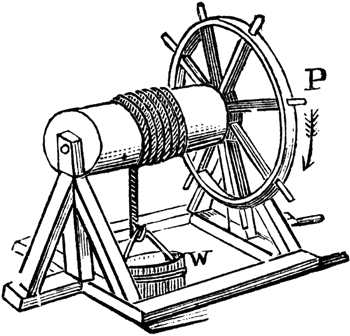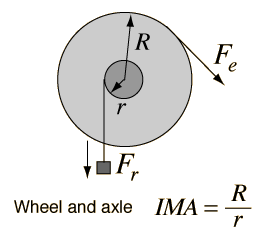Wheel and axle

The wheel and axle is a type of simple machine used to make tasks easier in terms of manipulating force by applying the concept of mechanical advantage. The wheel and axle consists of a round disk, known as a wheel, with a rod through the centre of it, known as the axle. This system uses angular momentum and torque to do work on objects, typically against the force of gravity. The wheel and axle simple machine is closely related to gears.
Like all other simple machines the wheel and axle system changes the force by changing the distance over which the force must be applied; if the input force is reduced to the output force, then the force must be applied over five times the distance. The work done is always force times distance, and this must always be the same because of the conservation of energy.
The wheel and axle both rotate at the same rate. What this means is that both the axle and the wheel will complete one full rotation in the same amount of time (as opposed to how gears work). Due to the size difference in the radius of the wheel and axle, this means that the distance the two parts rotate through in the same amount of time is different. This is due to the difference in the circumferences of the wheel itself and the axle that supports it. This supplies the conditions for mechanical advantage.
Mechanical advantage

The mechanical advantage for this system is ideally:[2]
where is the radius of the wheel, and is the radius of the axle, shown in Figure 2.
A wheel and axle system need a force in order to lift the load, but that force can be less than the weight of the object. Although the force a person needs to apply may not be very large compared to the force it does on the object, the distance they need to rotate the wheel is much larger than the distance the axle rotates through.
Ideally there are no losses during the energy transfer, but in reality there is no such thing as a system with 100% efficiency. Energy will be lost due to non-conservative forces such as friction, but wheel and axle systems often have very high efficiencies.
For Further Reading
For further information please see the related pages below:
References
- ↑ Wikimedia Commons [Online], Available: http://upload.wikimedia.org/wikipedia/commons/thumb/4/46/Wheelaxle_quackenbos.gif/250px-Wheelaxle_quackenbos.gif
- ↑ 2.0 2.1 Hyperphysics. (March 28, 2015). Simple machines [Online]. Available: http://hyperphysics.phy-astr.gsu.edu/hbase/mechanics/lever.html#c2

